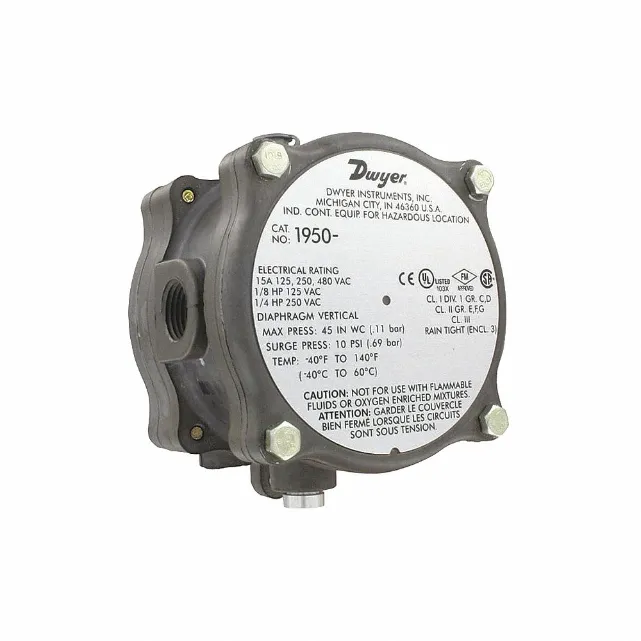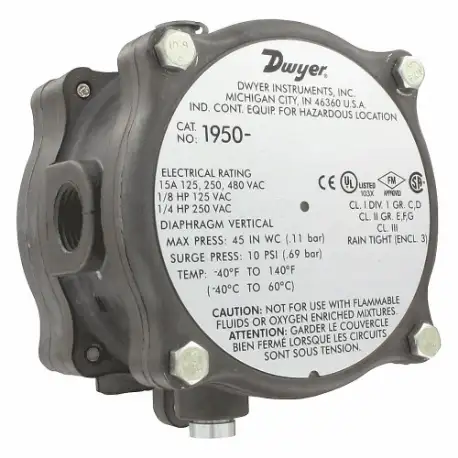Dwyer 1950-0-2F pressure switch is designed to monitor and control pressure in industrial and commercial applications. It has a single-pole, double-throw (SPDT) configuration, providing the flexibility to control two different circuits based on pressure thresholds.
Features:
- Dwyer Instruments 1950-0-2F pressure switch is CE-certified & FM-approved, explosion-proof housing for use in Class I, Div I, Groups C & D, Class II, Groups E, F & G and Class III hazardous environments.
- This pressure switch has an operating pressure range of 0.15 to 0.50 inch W.C. (water column) and an approximate dead band of 0.10 & 0.15 at minimum & maximum set-points, respectively.
- It comes with a cover, equipped with a drain plug & an O-ring seal for all-weather applications
- This Dwyer pressure switch has a set-point adjustment screw positioned outside the housing for user convenience.
- It can withstand temperatures ranging from -40 to 140 degrees F.
- This pressure switch has approximate deadband of 0.10 & 0.15 at minimum & maximum set-points, respectively.
- It is equipped with a NEMA-rated enclosure for use in outdoor conditions.
- This single-pole double-throw (SPDT) switch can be easily connected to the electrical supply through the removable front cover.
Standards and Approvals:
Frequently Asked Questions:
Q. How to install this Dwyer Instruments 1950-0-2F pressure switch?
A.
- Select an appropriate location that is free from vibration and is within operating conditions.
- Install the switch with the diaphragm placed in a vertical plane while the switch lettering & nameplate are in an upright position.
- Connect the switch's two 1/8 inch female NPT pressure ports to the pressure source of normal, vacuum or differential pressure type using any tubing that does not restrict the airflow. A low-pressure source is connected with the low-pressure port & a high-pressure source is connected to the high-pressure port.
- Make electrical connections by removing the cover's three hex head screws and loosening the fourth captive screw to swing aside the cover. Connect the circuit contacts. The normally open contacts close and the normally closed contacts open when pressure increases beyond the set point.
Q. How to change the set point of this Dwyer Instruments 1950-0-2F pressure switch?
A.
- Remove the plastic cap.
- Then, turn the slotted adjustment screw clockwise at the top of the housing for raising the set point pressure.
- Turn the screw counterclockwise for lowering the set point.
- Replace the plastic cap after calibration and re-check the set point.
Q. What are some steps to follow while performing a maintenance task on this Dwyer Instruments 1950-0-2F pressure switch?
A.
- Moving parts of this switch do not need regular maintenance or lubrication.
- The switch should be kept reasonably clean.
- The venting drain plug should be periodically rotated and returned to its original position to remove any deposits accumulated in switch applications having excessive condensation conditions.
Q. How is the pressure set and adjusted in Dwyer 1950-0-2F pressure switch?
A. The pressure is set and adjusted by a set screw up to the desired pressure threshold.
Q. Can Dwyer 1950-0-2F pressure switch be used in conjunction with a control system or automation equipment?
A. Yes, the brand's pressure switch can be integrated with control systems or automation equipment to enable automated pressure monitoring and control within a large system setup.
Q. What are the factors to consider while choosing this Dwyer 1950-0-2F pressure switch?
A. Major factors include pressure range, electrical ratings, switch type and housing material.
Q. How is this Dwyer 1950-0-2F pressure switch wired and connected to a control system?
A.
- Consult the user manual and provide a wiring diagram for model-specific instructions.
- Match the power supply voltage to the pressure switch's voltage rating and use appropriate wiring.
- Connect the pressure source to the pressure switch's ports using suitable fittings and adjust the pressure setpoint as needed.
- Connect the pressure switch's terminals (C, NO, NC) to the control system or monitoring equipment.
- Properly ground the pressure switch per local electrical codes and regulations.
- Seal electrical connections for protection in harsh environments.
- Perform a functional test to ensure the switch operates correctly at the setpoint.
- Prioritise safety by securing connections and ensuring proper positioning & mounting.
 Change Country
Change Country





